Chris Schuster, X Games ski sport organizer, sees a lot of the women successfully hitting the same size features as the guys. One of those competitors is Kaya Turski, who is able to land her entire run on the large features at X Games. But Turski says figuring out her speed in changing conditions is one of her biggest challenges. “Sometimes the jumps are fine in perfect weather, but introduce some wind and snow and often we just can’t clear it like the guys can,” she says. “It’s not an issue of talent, it’s purely because of our weight.”
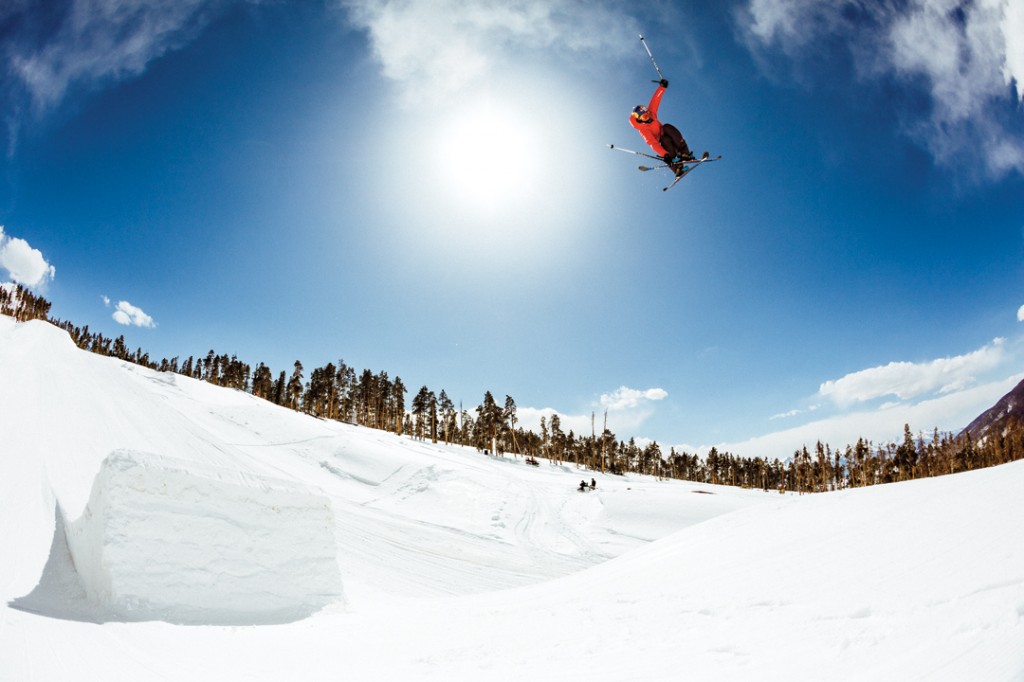
Tiril Sjåstad Christiansen at Keystone, CO. Photo by Nate Abbott.
Jacob Wester is an advocate of separate courses. “It doesn’t make any sense denying that there are physical differences between the sexes, so why should women two-thirds the weight of some men have to hit the same jumps in a slopestyle course?” he asks. “Add in weather and other factors, and it can get straight up dangerous. The courses nowadays are built according to the standards of male athletes, which made sense 10 years ago, but we should know better by now.”
At one point, separate takeoffs were common. “The problem we ran into,” says Schuster, “was that it was a lot of time and money to make separate takeoffs, and at the end of day, they weren’t getting much use. The people who were winning weren’t using them and that’s why they kind of went away.”
“…What’s better, a good 9 on a small jump or a sketchy 5 on a bigger jump?”
As slopestyle skiing and snowboarding tricks have evolved, athletes appreciate wider jumps that facilitate different rotations and carving tricks. Skivington points to this as part of the difficulty of bringing back multiple takeoffs. “If [the jump] goes on skiers’ left and you carve in from the right, you have a problem,” he explains. “Is having the lip moved forward worth losing carving space?”
“I’ve always been in favor of a mandatory smaller jump size for the ladies,” says skiing icon, Mike Douglas. “Not because I don’t know there are girls who can handle it. For any sport to have longevity and for it to build, you have to do it safely. The best girl will win on a 55-foot or 75-foot table. I guarantee there are 10 girls who can do a stylish cork 7 on a 50-foot table but only three who can do one on a 75-foot table. That’s counterproductive to the progression of the sport.”
How separate takeoffs would affect judging criteria stirs up more controversy. “What’s better, a good 9 on a small jump or a sketchy 5 on a bigger jump?” asks Wint rhetorically. “You can’t judge people on different courses. If they were to build smaller lips, everyone would need to hit the small side.”
“I would be content having two takeoffs,” says Turski. “I don’t consider that an insult. If I ended my ski career without blowing four knees, I’d be happy. There’s talk of us losing money and support, but the more we progress [our skiing], the more our sport is going to get recognized. If we take one step back, we’ll take many steps forward.”
Anatomy and Progression
“Across sports, not just freeskiing, female athletes have a higher incidence of ACL rupture than males,” says Laura Tietjen, a physical therapist for the United States Ski & Snowboard Association. According to Tietjen, female athletes need greater hip strength to avoid the inward collapse of their knees because of something called Q Angle. This angle that extends from the widest part of the hip to the middle of the kneecap is much larger in females. The alignment of women’s knees may predispose them to ACL injuries, but other factors play in, including women’s increased hamstring flexibility and foot pronation and variations in the nerves and muscles that control the position of the knee. In addition, the female hormone estrogen may relax or allow stretching of the ACL.
Meg Olenick sees the direct correlation between injury and a flat rate of development. “Progression took a lull for two years,” she says. “There weren’t a ton of new tricks. Kaya was winning with the same run for three or four years.”
That, says Turski, affects the sport’s progression. “It’s such a small field already. If you take out 50 percent of the top girls, the women aren’t challenged. You won’t push yourself to risk injury and a whole season if you don’t need to.”
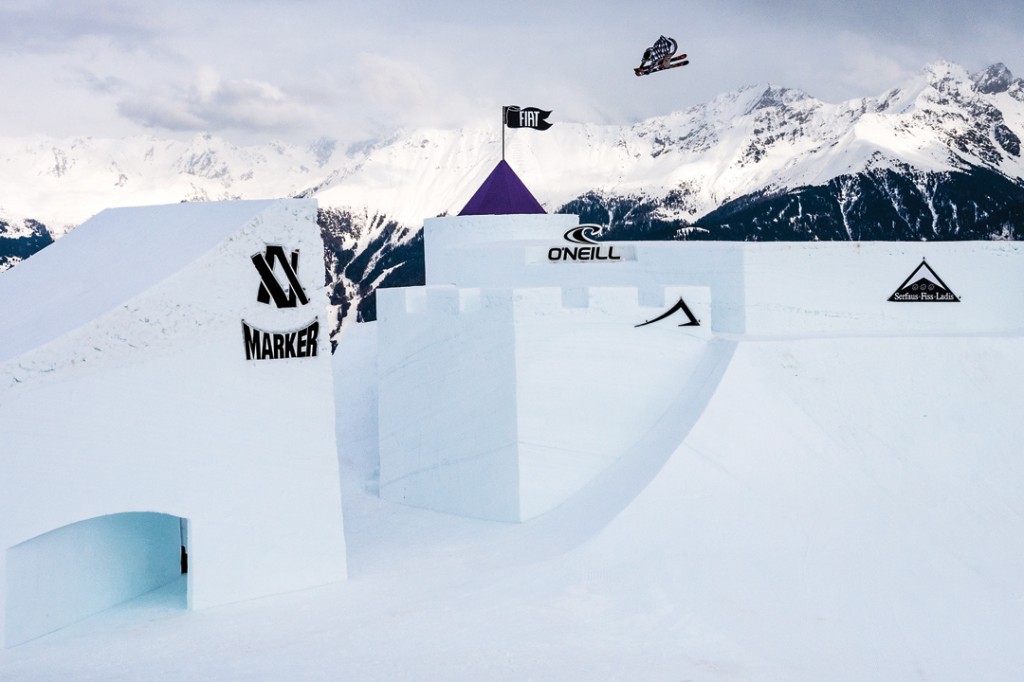
Lisa Zimmermann, Serfaus-Fiss-Ladis, AUS. Photo by Ethan Stone.
Despite the injury list, big things happened last year in women’s slopestyle skiing. At just 17 years old, German skier Lisa Zimmermann became the first female to land a double-cork 1260 in competition at the all-women’s Nine Queens big air contest in Austria. Zimmermann landed her double on a 55-foot jump. Additional contest firsts included British skier Katie Summerhayes landing a switch 1260 and Slovakia’s Zuzička Stromková putting down a rodeo 900.
Many of the women thought European X Games in Tignes, France, did it right. “The jumps were smaller than at any event all year and people were having a blast,” says Turski. “You had Mark McMorris and Torstein Horgmo still throwing their triples. Everyone did really well on that course. I tried some different rotations, and all the girls were stepping it up.”
Action
Jump size and separate takeoffs aside, Turski and Eliassen are adamant about safer contests when it comes to weather. “If it’s snowy or windy, you should still be able to make it through a course without casing anything or a contest should be canceled,” says Eliassen.
“There needs to be more drawing of the lines in terms of when to compete and when not to,” adds Turski. “You shouldn’t have to be lucky to make it through a course. We put thousands of hours into training, and then we have to sacrifice our bodies because they want the event to run at a certain time for TV.”
If female slopestyle skiers want reform, they are going to have to do more than talk about it. “My phone hasn’t rung once,” says Skivington. “If I was hearing from them, I’d be doing my best to do what they wanted. Anything can happen. Right now, I don’t have the female community asking for [separate takeoffs]. If I did, I’d start the conversation with [Dew Tour course builders] Snow Park Technologies and look into whether we could do this and if it makes sense.”
“I think it deserves attention and further discussion,” says Schuster. “An initial move would be for the girls to put something together and let the AFP know they want this broadly discussed with event organizers. There hasn’t been that kind of effort.”
Perhaps the ladies of skiing have been afraid to speak their minds. “It’s easy to talk about wanting smaller jumps, but to take action, you risk turning a large group of people—men and women—against you,” says Olenick. “I don’t know if any of the girls are willing to risk this in a small industry where having people against you is the last thing you want.”
But Raymond thinks it’s worth the risk, “Wouldn’t it be awesome to make the sport safer? To have no injuries this Olympic year, to have the full roster of women competing, to have girls throwing tricks people have never seen before in competition?”
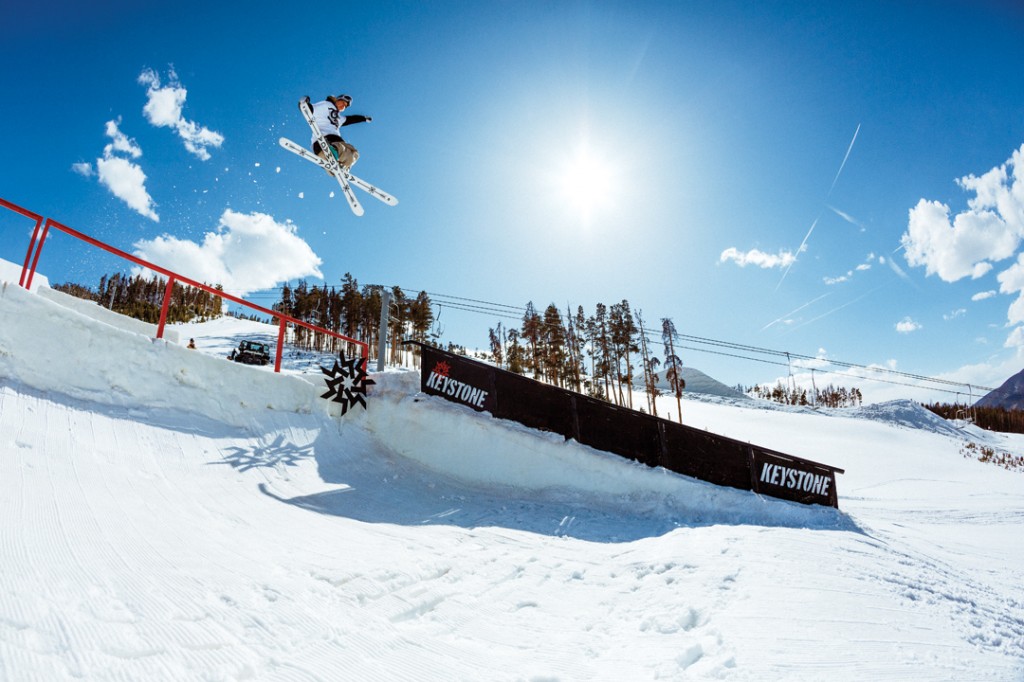
Maude Raymond at Keystone, CO. Photo by Nate Abbott.
Back in Keystone, it’s day three of the shoot. Raymond and Herman continue hitting the 75-foot jump, while Christiansen watches from the side. As the sun sets over the Gore Range, we move back to the smaller step over jump that has a better backdrop. Both the skiers are dropping switch 5s and 7s with solid grabs as the flash pops against the colorful clouds. They’ve reacted to changing conditions to showcase their skiing, now it’s up to the sport to do likewise.
End Note:
Several days before this article went to print, Tiril Sjåstad Christiansen suffered a knee injury at a Red Bull training camp in Aspen, CO. After a number of successful landings on a 60-foot jump, Christiansen attempted a left nine. She naturally spins right. “I don’t know what happened. Everything was going good and I felt like I was skiing well,” says Christiansen. “I landed a little forward and my knee popped. I couldn’t even move.” Christiansen got an MRI at the Aspen Valley Hospital, which confirmed a torn ACL and meniscus damage. She was recently named to the Norwegian Olympic freeskiing team, however, and is on site in Sochi; whether she will be ready to compete remains to be seen. We wish her the best in a full recovery.
Olympic Issue Download: This information was originally presented in Freeskier’s special edition, 2014 Olympic issue, available on iTunes beginning January 14. The Olympic issue will also be available on newsstands, as of the same date.



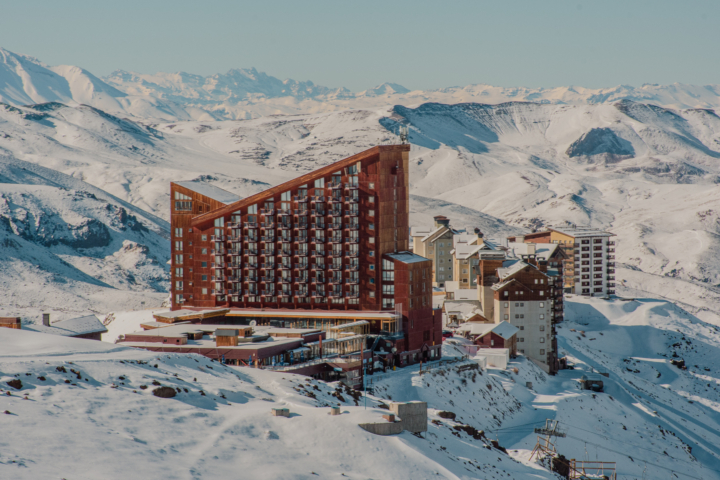


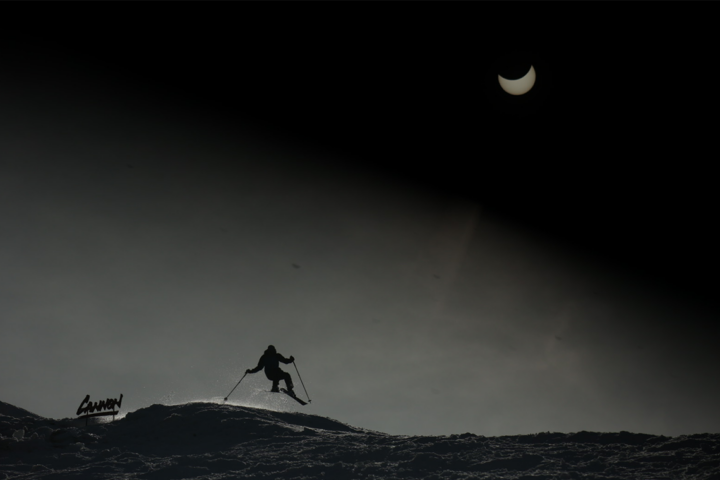


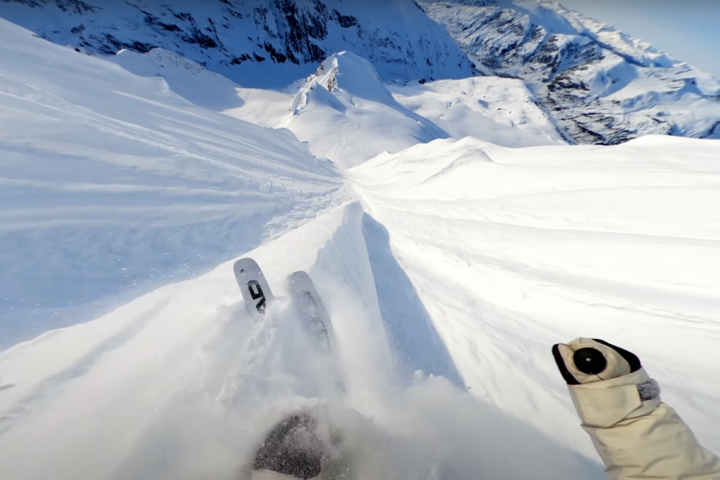
Comments are closed.